June marked the 25th Anniversary of Gramercy! Thank you to our valued investors, trusted business partners and team members without whom this milestone could not have been reached. We are excited for the opportunities we see ahead, and look forward to continuing to deliver upon our mission to have a positive impact on the well-being of our clients, portfolio investments (and their communities) and our team members.
Contents
Market Overview
Macro Review
Higher-for-longer in U.S. rates; volatile-for-longer in crude oil. An exceptionally strong NFP and JOLTS overshadow the weak ADP reading, which on balance is supported by the robust ISM Services data at 53.6 and Prices Paid was just below 60 (58.9). There were three important Central Bank comments over the week that stood out. Firstly, San Francisco Fed President Daly noted that the rise in yields in September “is equivalent to about a rate hike” and that the Fed can hold rates steady if the cooling of the labor market and inflation continues. Second, Richmond Fed President Barkin said that “we have time to see if we’ve done enough or whether there’s more work to do”. Then finally, the ECB’s Villeroy said the increase in bond yields may be excessive, but it is helping to tighten financing conditions. The subtle pushback initially helped global interest rates stabilize, but the strong NFP release, with prior month revisions, strengthened the higher-for-longer narrative. Crude oil was notably volatile around OPEC and technical CTA-related flows, having declined c.12% over the week and is well below the 50-day moving average, just as copper fell to a four-month low. Understandably this caused the S&P 500 to fall to a four-month low, having lost 8% since the peak in late-July, which also puts the ETF (SPY) close to the 200-day moving average. Spreads in U.S. High Yield markedly increased, with CDX HY above 500bps once again. Central banks in Australia and New Zealand held interest rates unchanged, along with India, but Poland cut by 25bps and Sri Lanka by 100bps. However, it was the rumored FX intervention in the Japanese yen that had market participants guessing. There was no official comment from the Japanese Ministry of Finance, which gave way to plenty of conspiracy theories. However, the trigger points in global FX were concerning given the ascent in DXY to a 10-month high and EUR falling to its lowest level against USD since December. These trends partially corrected toward the end of the week, but headlines were still made. In that regard, the 30-year U.S. Treasury rose above 5.0% for the first time since 2007. Fitch downgraded Panama to BBB- with a negative outlook, just as Moody’s downgraded Egypt to Caa1. The latter caused sizeable volatility on Friday, which will become an important talking point into IMF/World Bank meetings in Morocco next week. Similarly, the consternation around whether the EU will release €13bn in funding to Hungary that the block had frozen last year was equally topical. Finally, Turkish inflation came in at 61.5% with core CPI elevated at 68.9%, although the release may be overshadowed by geopolitics after the U.S. shot-down one of its drones in Kurdistan.
EM Credit Update
Emerging market sovereign credit (cash bonds) ended the week down 1.8% with credit spreads 23bps wider. Sovereign outperformers were Zambia, Mozambique and Georgia, while Ukraine, Tunisia and Argentina underperformed. The broader theme over the week was again around higher-for-longer in U.S. Treasuries, which some Fed officials accepted as meaning that another hike was less pressing, and then crude oil weakness. With oil down 12% over the week, EM corporates in the O&G sector only widened 15bps and returns were down -1.4%, which is a show of strength amid renewed volatility.
The Week Ahead
The steer of next week will likely be around non-farm payrolls given the significant beat, and to a lesser extent, by FOMC minutes and U.S. CPI. The quieter period with the U.S. bond market holiday and IMF/World Bank meetings taking place in Morocco could be short-lived. U.S. banks are due to deliver 3Q earnings and renewed balance sheet concerns are likely to be the theme. China’s PPI deflation likely eased on higher oil prices, where CPI in India and the U.S. may have softened. It is likely that weak external demand will continue to weigh on Asian exports too. With the return after Golden Week, the focus on Chinese data and the recovery through September will be key. An acceleration in money supply growth above 10% is likely having been helped by the 25bp RRR cut in mid-September. An improvement in credit expansion via total social financing growth and broader CNY loan growth are likely to be equally supportive. Inflation is also due out of Brazil, Czech Republic, India, Mexico, Poland and Romania. Poland’s inflation will likely match the preliminary figure from late September of 8.2% but a freeze in fuel prices is the main feature of this. Finally, Turkey will publish its current account balance and is expected to show only a very small deficit.
Highlights from emerging markets discussed below: The National Bank of Poland delivers a cautious rate cut amid a challenging global context, Calling off of nationwide strikes by Nigerian labor unions gives Tinubu Administration breathing room to sustain reforms and Evo Morales’ potential return to Bolivia’s political stage spooks markets.
Fixed Income
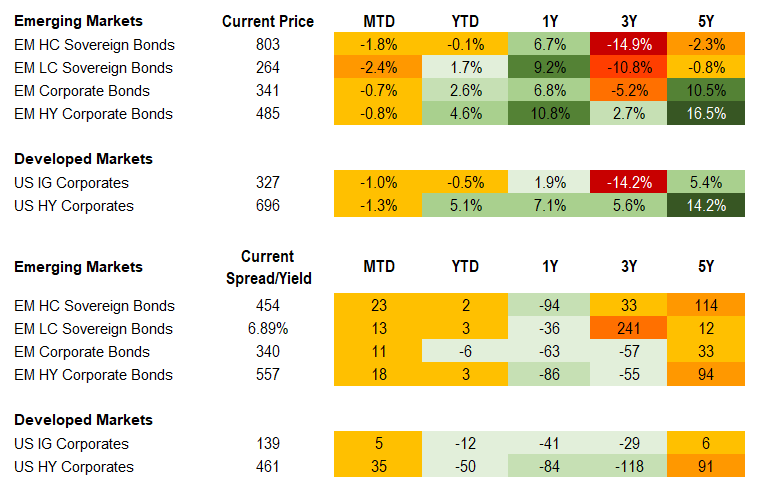
Equities
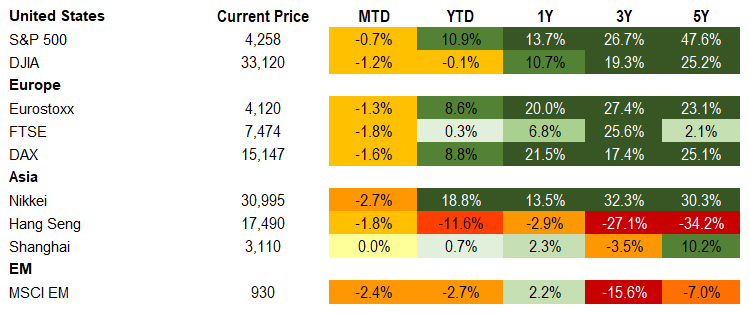
Commodities

Source for data tables: Bloomberg, JPMorgan, Gramercy. EM Fixed Income is represented by the following JPMorgan Indicies: EMBI Global, GBI-EM Global Diversified, CEMBI Broad Diversified and CEMBI Broad High Yield. DM Fixed Income is represented by the JPMorgan JULI Total Return Index and Domestic High Yield Index. Fixed Income, Equity and Commodity data is as of October 6, 2023 (mid-afternoon).
Emerging Markets Weekly Highlights
The National Bank of Poland delivers a cautious rate cut amid a challenging global context
Event: The Central Bank of Poland (NBP) lowered its benchmark rate by 25bps to 5.75% from 6.0%, moderating the rate of easing from the surprise 75bps rate cut delivered in September.
Gramercy commentary: This is the second consecutive rate cut, but, unlike last month when the authorities surprised markets with a jumbo 75bps cut, this was in line with market expectations. Meanwhile, inflation has inched downwards to 8.2% YoY in September, from 10.1% YoY in August, driven by food disinflation, administrative adjustments in electricity prices and declining gasoline prices, thanks to the monopoly player in the market keeping prices at reduced levels. The more measured policy rate adjustment this time around helped avoid a deeper depreciation of the PLN amid already challenging global macro conditions for EMFX in general. In addition to monetary policy calibration, the market remains focused on the upcoming October 15th Parliamentary Elections, which could have significant implications for Poland’s economic and foreign policy trajectory. Concerns around politically motivated policy easing are likely to linger, however, Governor Glapinski appeared to signal that the NBP sees narrower room for cuts going forward, considering the 4% depreciation of the Zloty after the September decision.
Calling off of nationwide strikes by Nigerian labor unions gives Tinubu Administration breathing room to sustain reforms
Event: Nigeria Labor Congress, the umbrella organization of labor unions in Nigeria, suspended a nationwide strike to protest cost-of-living increases due to removal of fuel subsidies.
Gramercy commentary: Ambitious reforms being implemented by the Tinubu Administration since taking office in May, specifically the removal of fuel subsidies and FX regime liberalization, have been welcomed by markets but also come with significant social and political costs. In this context, the authorities’ putting forward measures to ease cost-of-living pressure is a critical step toward improving the odds of the reforms being successfully implemented. The measures include a temporary pay increase for federal government employees and payments to 15 million poor households for three months. The suspension of the strikes buys the Tinubu Administration time to focus on streamlining its efforts and improving the delicate balance between tackling longstanding economic inefficiencies while supporting the most vulnerable groups in society. Amid significant macroeconomic challenges in the form of FX liquidity shortages and still elevated inflation levels, prudent target policy action by the authorities will be essential during the quarter to restore confidence locally and among international investors.
Evo Morales’ potential return to Bolivia’s political stage spooks markets
Event: Evo Morales, Bolivia’s left-wing President from 2006 until 2019, declared his intention to return to politics and run for president again in 2025.
Gramercy commentary: Evo Morales’ fresh political aspirations caused underperformance by Bolivia’s Eurobond curve, driving the sovereign complex back to levels last seen in April when investors were concerned about a potential default event amid hard currency liquidity pressures. This time around, escalating political noise is driving the weakness. Namely, the political committee of Bolivia’s ruling party restored Morales as its leader and candidate for the 2025 elections and declared the expulsion of current President Luis Arce. From a market perspective, Morales has a long track record of heterodox economic and foreign policy inclinations. While Bolivia faces a relatively benign repayment schedule in the near-term and benefits from a debt profile dominated by concessional financing, we do not see significant constructive catalysts on the horizon, unless a material decrease in political noise materializes..
Emerging Markets Technicals
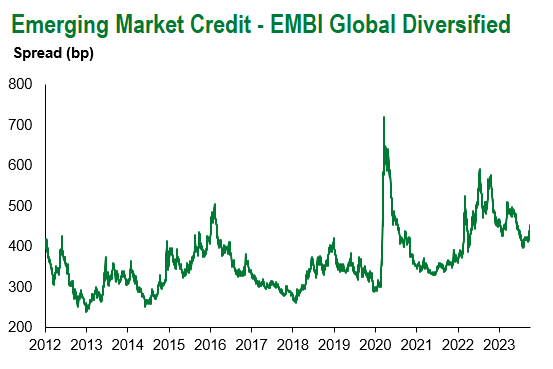
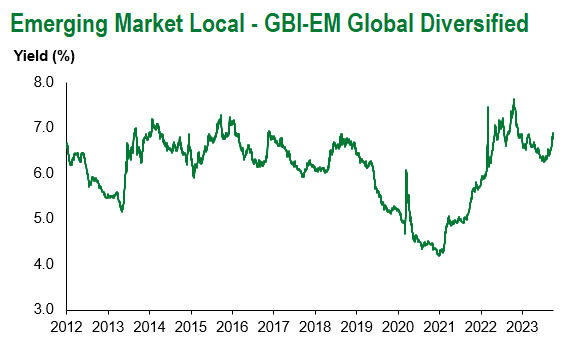
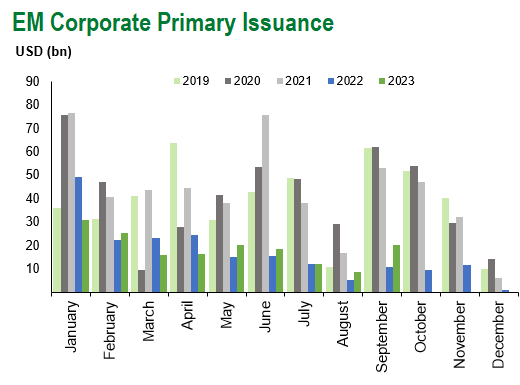
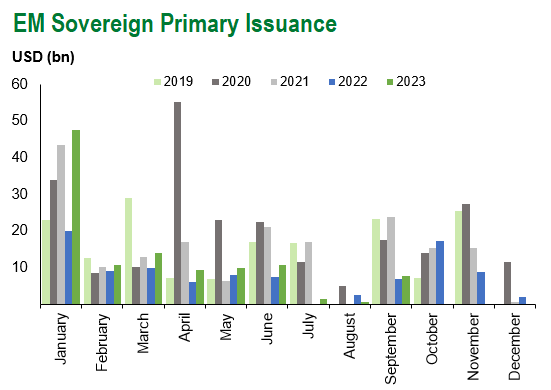
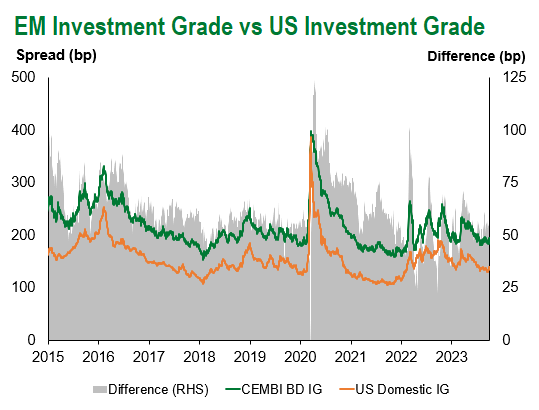
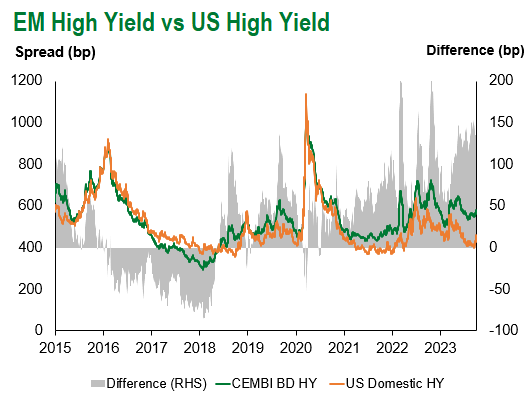
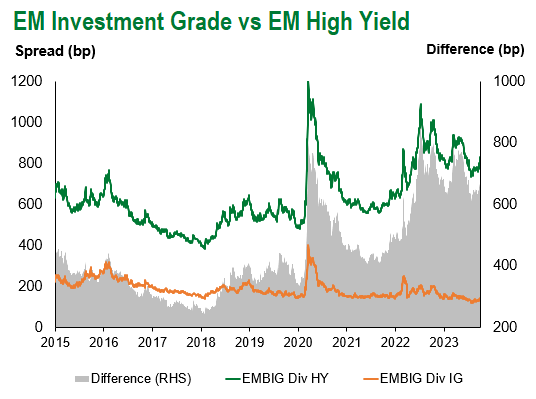
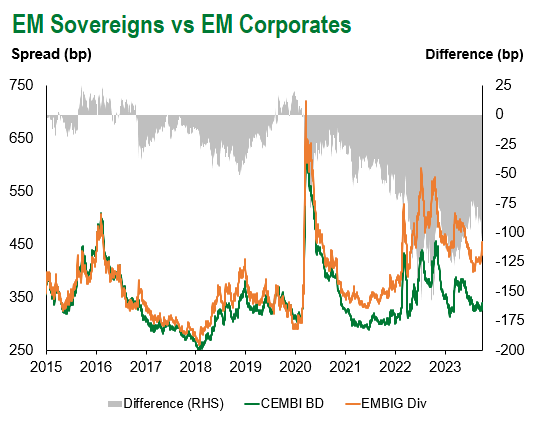
Emerging Markets Flows
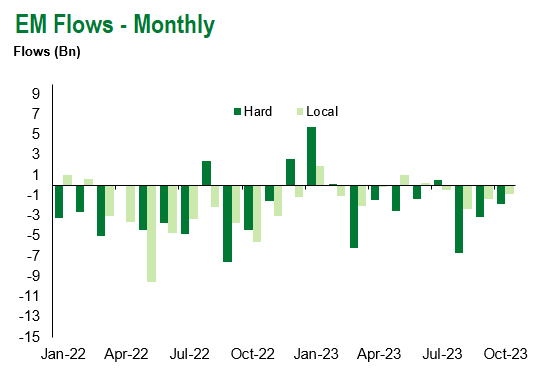
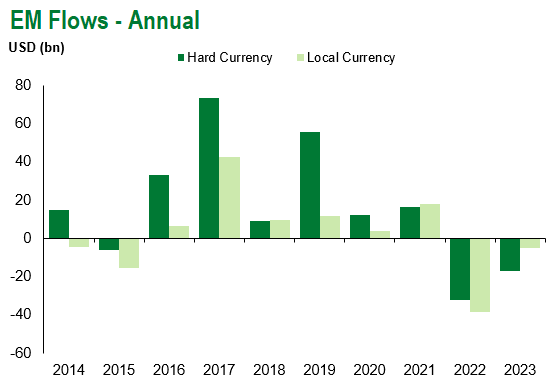
Source for graphs: Bloomberg, JPMorgan, Gramercy. As of October 6, 2023.
For questions, please contact:
Kathryn Exum, CFA ESG, Director, Co-Head of Sovereign Research, [email protected]
Petar Atanasov, Director, Co-Head of Sovereign Research, [email protected]
James Barry, Director, Deputy Portfolio Manager, [email protected]
This document is for informational purposes only. The information presented is not intended to be relied upon as a forecast, research or investment advice, and is not a recommendation, offer or solicitation to buy or sell any securities or to adopt any investment strategy. Gramercy may have current investment positions in the securities or sovereigns mentioned above. The information and opinions contained in this paper are as of the date of initial publication, derived from proprietary and nonproprietary sources deemed by Gramercy to be reliable, are not necessarily all-inclusive and are not guaranteed as to accuracy. This paper may contain “forward-looking” information that is not purely historical in nature. Such information may include, among other things, projections and forecasts. There is no guarantee that any forecasts made will come to pass. Reliance upon information in this paper is at the sole discretion of the reader. You should not rely on this presentation as the basis upon which to make an investment decision. Investment involves risk. There can be no assurance that investment objectives will be achieved. Investors must be prepared to bear the risk of a total loss of their investment. These risks are often heightened for investments in emerging/developing markets or smaller capital markets. International investing involves risks, including risks related to foreign currency, limited liquidity, less government regulation, and the possibility of substantial volatility due to adverse political, economic or other developments. References to any indices are for informational and general comparative purposes only. The performance data of various indices mentioned in this update are updated and released on a periodic basis before finalization. The performance data of various indices presented herein was current as of the date of the presentation. Please refer to data returns of the separate indices if you desire additional or updated information. Indices are unmanaged, and their performance results do not reflect the impact of fees, expenses, or taxes that may be incurred through an investment with Gramercy. Returns for indices assume dividend reinvestment. An investment cannot be made directly in an index. Accordingly, comparing results shown to those of such indices may be of limited use. The information provided herein is neither tax nor legal advice. Investors should speak to their tax professional for specific information regarding their tax situation.
